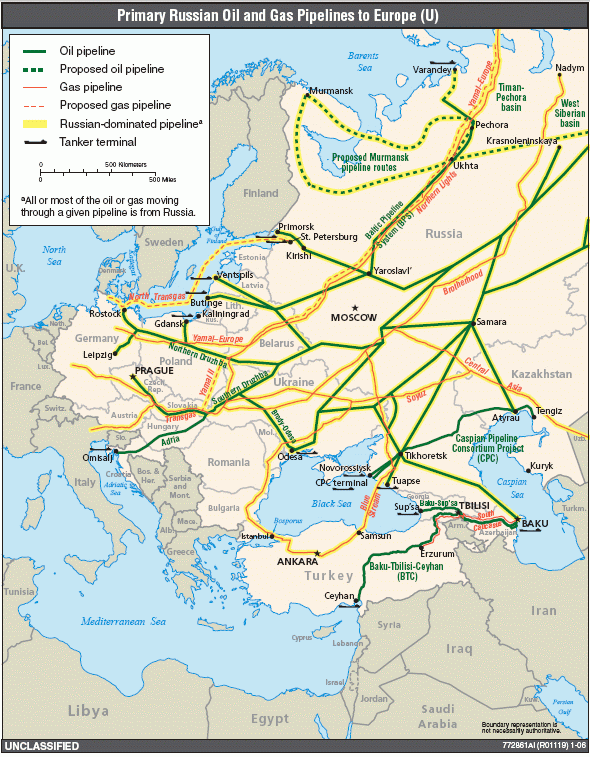Siberia
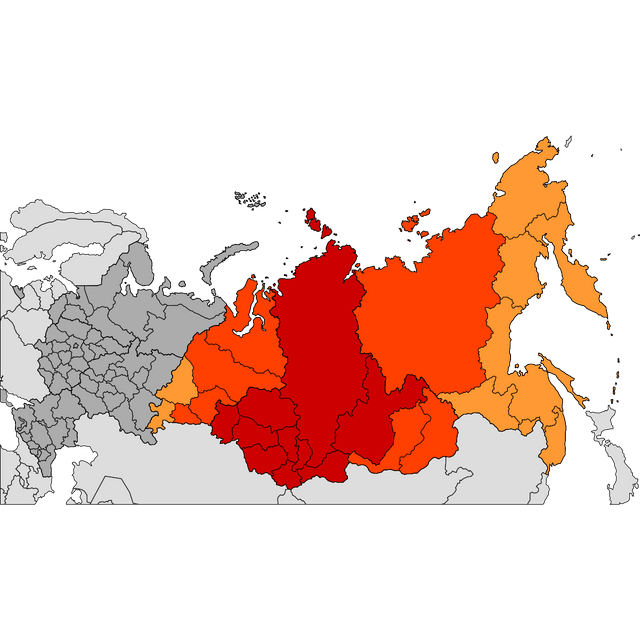
Siberia

The territory of Siberia extends eastwards from the Ural Mountains to the watershed
between the Pacific and Arctic drainage basins. The Yenisei River conditionally divides Siberia into two parts, Western and Eastern. Siberia stretches southwards from the Arctic Ocean to the hills of north-central Kazakhstan and to the national borders of Mongolia and China.[1]
With an area of 13.1 million square kilometres (5,100,000 sq mi), Siberia accounts for 77% of Russia's land area, but it is home to approximately 36 million people—27% of the country's population. This is equivalent to an average population density of about 3 inhabitants per square kilometre (7.8/sq mi) (approximately equal to that of Australia), making Siberia one of the most sparsely populated regions on Earth. If it were a country by itself, it would still be the largest country in area, but in population it would be the world's 35th-largest and Asia's 14th-largest.
Etymology
The origin of the name is unknown. Some sources say that "Siberia" originates from the Siberian Tatar word for "sleeping land" (Sib Ir).[3] Another account sees the name as the ancient tribal ethnonym of the Sirtya (also "Syopyr" (sʲɵpᵻr)), an ethnic group which spoke a Paleosiberian language. The Sirtya people were later assimilated into the Siberian Tatars.
The modern usage of the name was recorded in the Russian language after the Empire's conquest of the Siberian Khanate. A further variant claims that the region was named after the Xibe people.[4] The Polish historian Chyliczkowski has proposed that the name derives from the proto-Slavic word for "north" (север, sever),[5] same as Severia.
Anatole Baikaloff has dismissed this explanation. He said that the neighbouring Chinese, Turks, and Mongolians, who have similar names for the region, would not have known Russian. He suggests that the name might be a combination of two words with Turkic origin, "su" (water) and "bir" (wild land).[6]
Prehistory
The region has paleontological significance, as it contains bodies of prehistoric animals from the Pleistocene Epoch, preserved in ice or in permafrost. Specimens of Goldfuss cave lion cubs, Yuka (mammoth) and another woolly mammoth from Oymyakon, a woolly rhinoceros from the Kolyma River, and bison and horses from Yukagir have been found.[7]
The Siberian Traps were formed by one of the largest-known volcanic events of the last 500 million years of Earth's geological history. Their activity continued for a million years and some scientists consider it a possible cause of the "Great Dying" about 250 million years ago,[8] – estimated to have killed 90% of species existing at the time.[9]
At least three species of human lived in Southern Siberia around 40,000 years ago: H. sapiens, H. neanderthalensis, and the Denisovans.[10] In 2010 DNA evidence identified the last as a separate species.
History
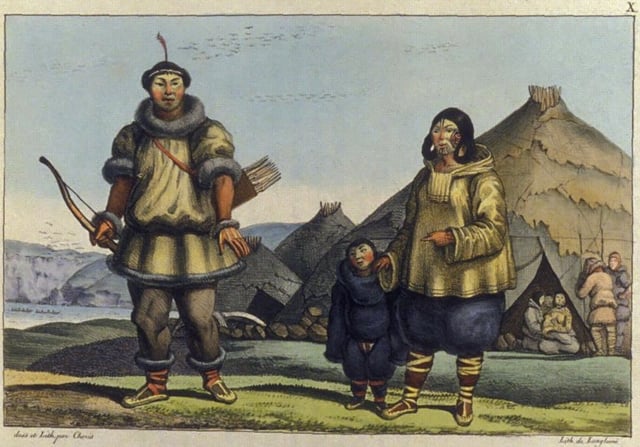
Chukchi, one of many indigenous peoples of Siberia. Representation of a Chukchi family by Louis Choris (1816)

Map of the Siberian Route in the 18th century (green) and the early 19th century (red).
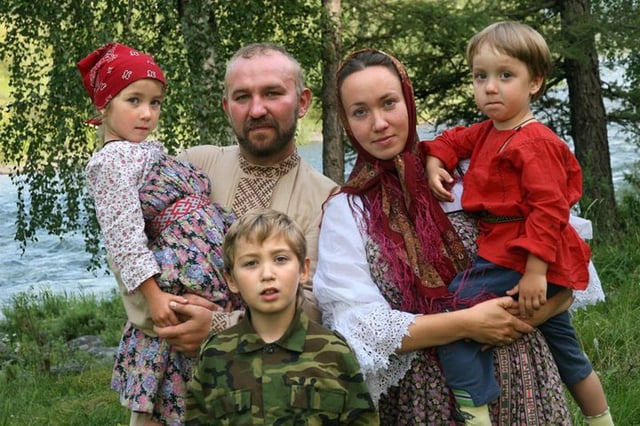
Siberian Cossack family in Novosibirsk
During past millennia different groups of nomads – such as the Enets, the Nenets, the Huns, the Xiongnu, the Scythians and the Uyghurs inhabited various parts of Siberia. The proto-Mongol Khitan people also occupied parts of the region. In 630 the Khan of Sibir in the vicinity of modern Tobolsk was known as a prominent figure who endorsed Kubrat as Khagan of Old Great Bulgaria. In the 13th century, during the period of the Mongol Empire, the Mongols conquered a large part of this area.[11]
With the breakup of the Golden Horde, the autonomous Khanate of Sibir formed in the late-15th century. Turkic-speaking Yakut migrated north from the Lake Baikal region under pressure from the Mongol tribes during the 13th to 15th century.[12] Siberia remained a sparsely populated area. Historian John F. Richards wrote: "... it is doubtful that the total early modern Siberian population exceeded 300,000 persons".[13]
The growing power of Russia in the West began to undermine the Siberian Khanate in the 16th century. First, groups of traders and Cossacks began to enter the area. The Russian Army was directed to establish forts farther and farther east to protect new settlers who migrated from European Russia. Towns such as Mangazeya, Tara, Yeniseysk and Tobolsk developed, the last becoming the de facto capital of Siberia from 1590. At this time, Sibir was the name of a fortress at Qashlik, near Tobolsk. Gerardus Mercator, in a map published in 1595, marks Sibier both as the name of a settlement and of the surrounding territory along a left tributary of the Ob.[14] Other sources contend that the Xibe, an indigenous Tungusic people, offered fierce resistance to Russian expansion beyond the Urals. Some suggest that the term "Siberia" is a Russification of their ethnonym.
The first great modern change in Siberia was the Trans-Siberian Railway, constructed during 1891–1916. It linked Siberia more closely to the rapidly industrialising Russia of Nicholas II (r. 1894–1917). Around seven million people moved to Siberia from European Russia between 1801 and 1914.[19] Between 1859 and 1917 more than half a million people migrated to the Russian Far East.[20] Siberia has extensive natural resources: during the 20th century, large-scale exploitation of these took place, and industrial towns cropped up throughout the region.[21]
At 7:15 a.m. on 30 June 1908 the Tunguska Event felled millions of trees near the Podkamennaya Tunguska (Stony Tunguska) River in central Siberia. Most scientists believe this resulted from the air burst of a meteor or a comet. Even though no crater has ever been found, the landscape in the (sparsely inhabited) area still bears the scars of this event.[22]
In the early decades of the Soviet Union (especially in the 1930s and 1940s), the government used the Gulag state agency to administer a system of penal labour camps, replacing the previous katorga system.[23] According to semi-official Soviet estimates, which did not become public until after the fall of the Soviet government in 1991, from 1929 to 1953 more than 14 million people passed through these camps and prisons, many of them in Siberia. Another seven to eight million people were internally deported to remote areas of the Soviet Union (including entire nationalities or ethnicities in several cases).[24]
Half a million (516,841) prisoners died in camps from 1941 to 1943[25] due to food shortages caused by World War II. At other periods, mortality was comparatively lower.[26] The size, scope, and scale of the Gulag slave-labour camps remain subjects of much research and debate. Many Gulag camps operated in extremely remote areas of northeastern Siberia. The best-known clusters included Sevvostlag (the North-East Camps) along the Kolyma River and Norillag near Norilsk, where 69,000 prisoners lived in 1952.[27] Major industrial cities of Northern Siberia, such as Norilsk and Magadan, developed from camps built by prisoners and run by former prisoners.[28]
Geography
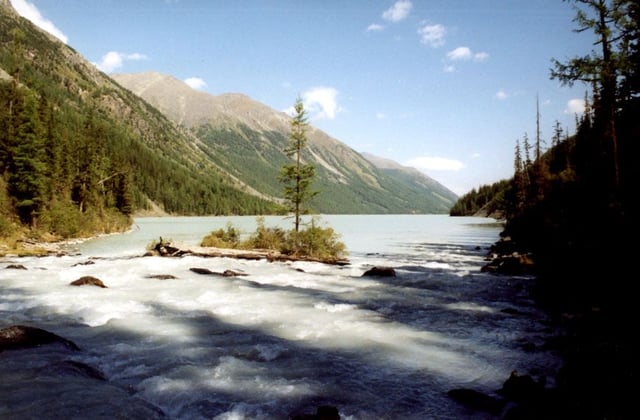
Altai, Lake Kutsherla in the Altai Mountains
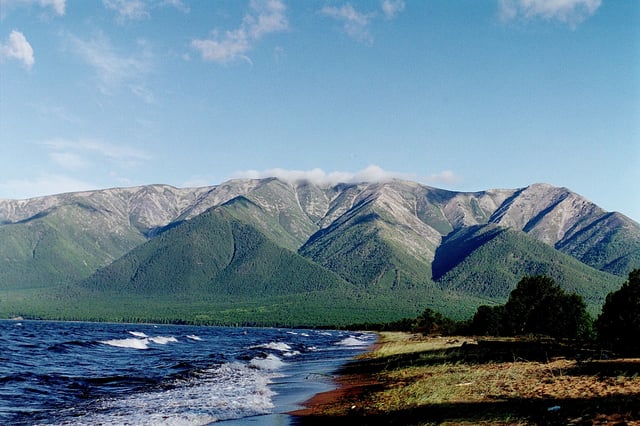
The peninsula of Svyatoy Nos, Lake Baikal
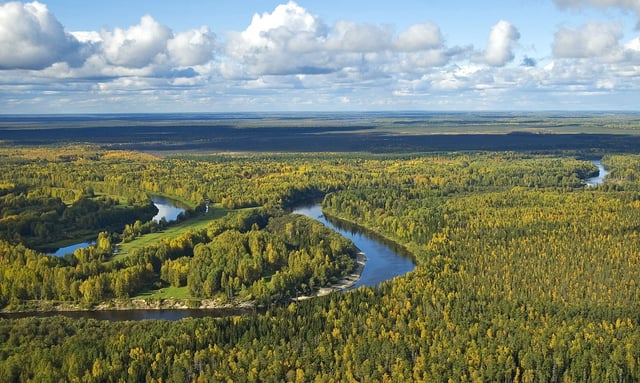
Vasyugan River in the southern West Siberian Plain
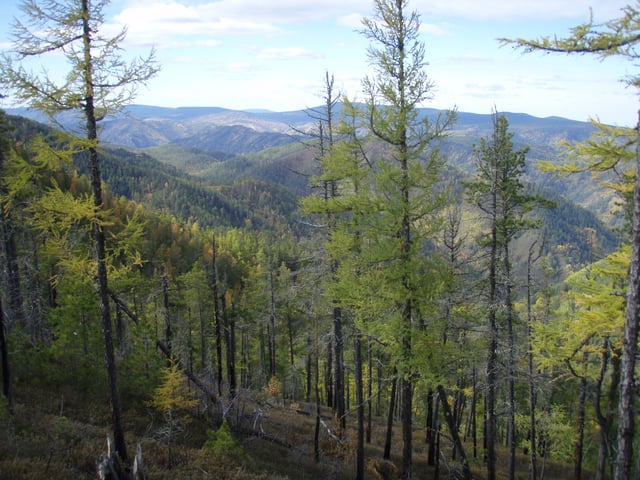
Siberian taiga
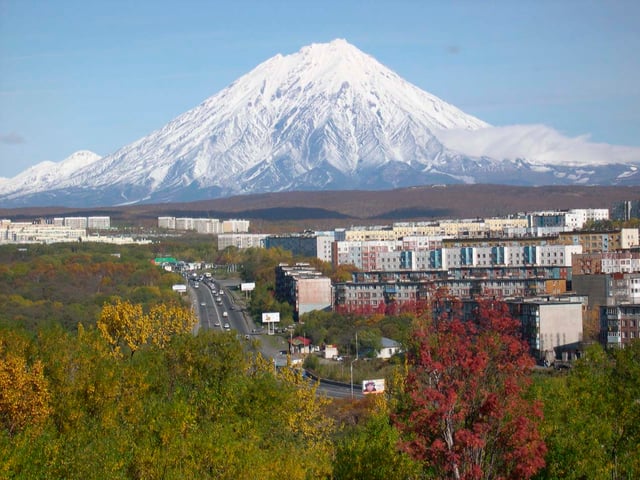
Koryaksky volcano towering over Petropavlovsk-Kamchatsky on the Kamchatka Peninsula
With an area of 13.1 million square kilometres (5,100,000 sq mi), Siberia makes up roughly 77% of Russia's total territory and almost 9% of Earth's land surface (148,940,000 km2, 57,510,000 sq mi). While Siberia falls entirely within Asia, many authorities such as the UN geoscheme will not subdivide countries and will place all of Russia as part of Europe and/or Eastern Europe. Major geographical zones include the West Siberian Plain and the Central Siberian Plateau.
Eastern and central Sakha comprises numerous north-south mountain ranges of various ages. These mountains extend up to almost 3,000 metres (9,800 ft), but above a few hundred metres they are almost completely devoid of vegetation. The Verkhoyansk Range was extensively glaciated in the Pleistocene, but the climate was too dry for glaciation to extend to low elevations. At these low elevations are numerous valleys, many of them deep and covered with larch forest, except in the extreme north where the tundra dominates. Soils are mainly turbels (a type of gelisol). The active layer tends to be less than one metre deep, except near rivers.
The highest point in Siberia is the active volcano Klyuchevskaya Sopka, on the Kamchatka Peninsula. Its peak is at 4,750 metres (15,580 ft).
Mountain ranges
Altai Mountains
Anadyr Range
Baikal Mountains
Chamar-Daban
Chersky Range
Dzhugdzhur Mountains
Gydan Mountains
Koryak Mountains
Sayan Mountains
Tannu-Ola Mountains
Verkhoyansk Mountains
Yablonoi Mountains
Lakes and rivers
Anabar River
Angara River
Indigirka River
Irtysh River
Kolyma River
Lake Baikal
Lena River
Lower Tunguska River
Novosibirsk Reservoir
Ob River
Popigay River
Stony Tunguska River
Upper Angara River
Uvs Nuur
Yana River
Yenisei River
Grasslands
Ukok Plateau – part of a UNESCO World Heritage Site[29]
Geology
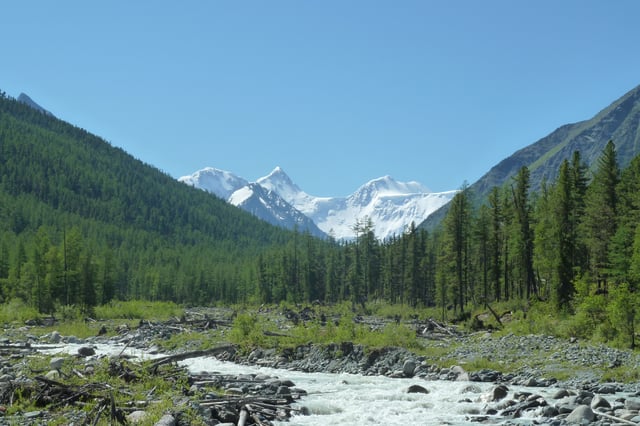
Belukha Mountain
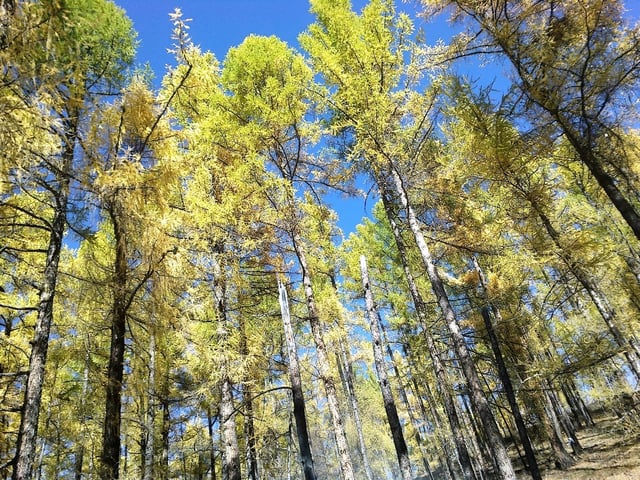
Autumn forest in the eastern Sayan Mountains, Buryatia
The West Siberian Plain consists mostly of Cenozoic alluvial deposits and is somewhat flat. Many deposits on this plain result from ice dams which produced a large glacial lake. This mid- to late-Pleistocene lake blocked the northward flow of the Ob and Yenisei rivers, resulting in a redirection southwest into the Caspian and Aral seas via the Turgai Valley.[30] The area is very swampy, and soils are mostly peaty histosols and, in the treeless northern part, histels. In the south of the plain, where permafrost is largely absent, rich grasslands that are an extension of the Kazakh Steppe formed the original vegetation, most of which is no longer visible.
The Central Siberian Plateau is an ancient craton (sometimes named Angaraland) that formed an independent continent before the Permian (see the Siberian continent). It is exceptionally rich in minerals, containing large deposits of gold, diamonds, and ores of manganese, lead, zinc, nickel, cobalt and molybdenum. Much of the area includes the Siberian Traps—a large igneous province. This massive eruptive period was approximately coincident with the Permian–Triassic extinction event. The volcanic event is said to be the largest known volcanic eruption in Earth's history. Only the extreme northwest was glaciated during the Quaternary, but almost all is under exceptionally deep permafrost, and the only tree that can thrive, despite the warm summers, is the deciduous Siberian Larch (Larix sibirica) with its very shallow roots. Outside the extreme northwest, the taiga is dominant, covering a significant fraction of the entirety of Siberia.[31] Soils here are mainly turbels, giving way to spodosols where the active layer becomes thicker and the ice content lower.
The Lena-Tunguska petroleum province includes the Central Siberian platform (some authors refer to it as the Eastern Siberian platform), bounded on the northeast and east by the Late Carboniferous through Jurassic Verkhoyansk foldbelt, on the northwest by the Paleozoic Taymr foldbelt, and on the southeast, south and southwest by the Middle Silurian to Middle Devonian Baykalian foldbelt.[32] [] A regional geologic reconnaissance study begun in 1932, followed by surface and subsurface mapping, revealed the Markova-Angara Arch (anticline). This led to the discovery of the Markovo Oil Field in 1962 with the Markovo 1 well, which produced from the Early Cambrian Osa Horizon bar-sandstone at a depth of 2,156 metres (7,073 ft).[32] [] The Sredne-Botuobin Gas Field was discovered in 1970, producing from the Osa and the Proterozoic Parfenovo Horizon.[32] [] The Yaraktin Oil Field was discovered in 1971, producing from the Vendian Yaraktin Horizon at depths of up to 1,750 metres (5,740 ft), which lies below Permian to Lower Jurassic basalt traps.[32] []
Climate

Taiga near Lake Baikal
 |
| polar desert tundra alpine tundra taiga montane forest temperate broadleaf forest temperate steppe dry steppe |
| Vegetation in Siberia is mostly taiga, with a tundra belt on the northern fringe, and a temperate forest zone in the south. |
The climate of Siberia varies dramatically, but it typically has short summers and long, brutally cold winters. On the north coast, north of the Arctic Circle, there is a very short (about one-month-long) summer.
Almost all the population lives in the south, along the Trans-Siberian Railway. The climate in this southernmost part is Humid continental climate (Köppen Dfb) with cold winters but fairly warm summers lasting at least four months. The annual average is about 0.5 °C (32.9 °F). January averages about −20 °C (−4 °F) and July about +19 °C (66 °F) while daytime temperatures in summer typically are above 20 °C (68 °F).[33][34] With a reliable growing season, an abundance of sunshine and exceedingly fertile chernozem soils, southern Siberia is good enough for profitable agriculture, as was proven in the early 20th century.
By far the most commonly occurring climate in Siberia is continental subarctic (Koppen Dfc or Dwc), with the annual average temperature about −5 °C (23 °F) and an average for January of −25 °C (−13 °F) and an average for July of +17 °C (63 °F),[35] although this varies considerably, with a July average about 10 °C (50 °F) in the taiga–tundra ecotone. The Business oriented website and blog Business Insider lists Verkhoyansk and Oymyakon, in Siberia's Sakha Republic, as being in competition for the title of the Northern Hemisphere's Pole of Cold. Oymyakon is a village which recorded a temperature of −67.7 °C (−89.9 °F) on 6 February 1933. Verkhoyansk, a town further north and further inland, recorded a temperature of −69.8 °C (−93.6 °F) for three consecutive nights: 5, 6 and 7 February 1933. Each town is alternately considered the Northern Hemisphere's Pole of Cold, meaning the coldest inhabited point in the Northern hemisphere. Each town also frequently reaches 86 °F (30 °C) in the summer, giving them, and much of the rest of Russian Siberia, the world's greatest temperature variation between summer's highs and winter's lows, often being well over 170–180+ °F (94–100+ °C) between the seasons.[36]
Southwesterly winds bring warm air from Central Asia and the Middle East. The climate in West Siberia (Omsk, Novosibirsk) is several degrees warmer than in the East (Irkutsk, Chita) where in the north an extreme winter subarctic climate (Köppen Dfd or Dwd) prevails. But summer temperatures in other regions can reach +38 °C (100 °F). In general, Sakha is the coldest Siberian region, and the basin of the Yana River has the lowest temperatures of all, with permafrost reaching 1,493 metres (4,898 ft). Nevertheless, as far as Imperial Russian plans of settlement were concerned, cold was never viewed as an impediment. In the winter, southern Siberia sits near the center of the semi-permanent Siberian High, so winds are usually light in the winter.
Precipitation in Siberia is generally low, exceeding 500 millimetres (20 in) only in Kamchatka where moist winds flow from the Sea of Okhotsk onto high mountains – producing the region's only major glaciers, though volcanic eruptions and low summer temperatures allow limited forests to grow. Precipitation is high also in most of Primorye in the extreme south where monsoonal influences can produce quite heavy summer rainfall.
| Climate data for Novosibirsk, Siberia's largest city | |||||||||||||
|---|---|---|---|---|---|---|---|---|---|---|---|---|---|
| Month | Jan | Feb | Mar | Apr | May | Jun | Jul | Aug | Sep | Oct | Nov | Dec | Year |
| Average high °C (°F) | −12.2 (10.0) | −10.3 (13.5) | −2.6 (27.3) | 8.1 (46.6) | 17.5 (63.5) | 24.0 (75.2) | 25.7 (78.3) | 22.2 (72.0) | 16.6 (61.9) | 6.8 (44.2) | −2.9 (26.8) | −8.9 (16.0) | 7.0 (44.6) |
| Daily mean °C (°F) | −16.2 (2.8) | −14.7 (5.5) | −7.2 (19.0) | 3.2 (37.8) | 11.6 (52.9) | 18.2 (64.8) | 20.2 (68.4) | 17.0 (62.6) | 11.5 (52.7) | 3.4 (38.1) | −6 (21) | −12.7 (9.1) | 2.4 (36.3) |
| Average low °C (°F) | −20.1 (−4.2) | −19.1 (−2.4) | −11.8 (10.8) | −1.7 (28.9) | 5.6 (42.1) | 12.3 (54.1) | 14.7 (58.5) | 11.7 (53.1) | 6.4 (43.5) | 0.0 (32.0) | −9.1 (15.6) | −16.4 (2.5) | −2.3 (27.9) |
| Average precipitation mm (inches) | 19 (0.7) | 14 (0.6) | 15 (0.6) | 24 (0.9) | 36 (1.4) | 58 (2.3) | 72 (2.8) | 66 (2.6) | 44 (1.7) | 38 (1.5) | 32 (1.3) | 24 (0.9) | 442 (17.4) |
| Source: [37] | |||||||||||||
Researchers, including Sergei Kirpotin at Tomsk State University and Judith Marquand at Oxford University, warn that Western Siberia has begun to thaw as a result of global warming. The frozen peat bogs in this region may hold billions of tons of methane gas, which may be released into the atmosphere. Methane is a greenhouse gas 22 times more powerful than carbon dioxide.[38] In 2008, a research expedition for the American Geophysical Union detected levels of methane up to 100 times above normal in the atmosphere above the Siberian Arctic, likely the result of methane clathrates being released through holes in a frozen 'lid' of seabed permafrost, around the outfall of the Lena River and the area between the Laptev Sea and East Siberian Sea.[39][40]
Fauna
Order Carnivora
Family Ursidae
Asian black bear[45]
Politics
Borders and administrative division

Map of the most populated area of Siberia [94] with clickable city names (SVG)

Comparison of the nine biggest Siberian cities' growth in the 20th century [95]
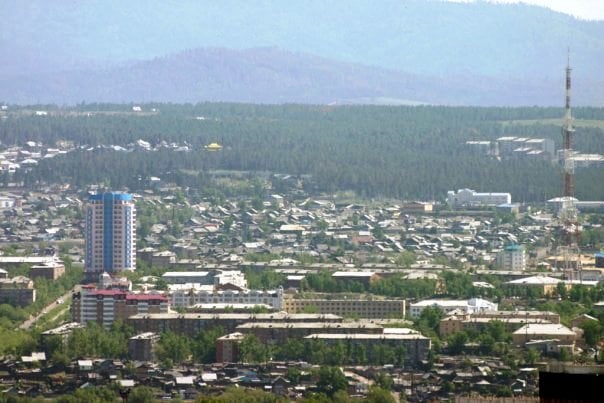
Ulan-Ude
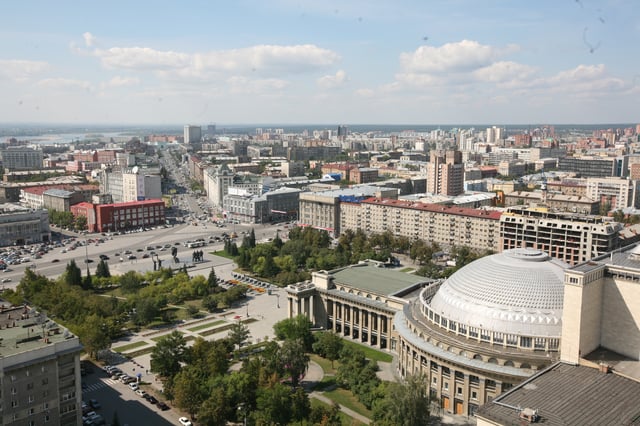
Novosibirsk is the largest city in Siberia
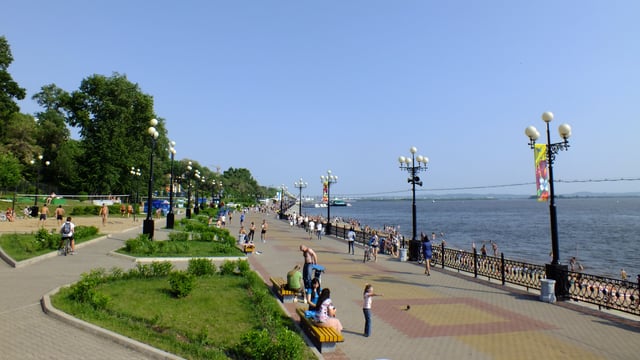
Amur waterfront in Khabarovsk
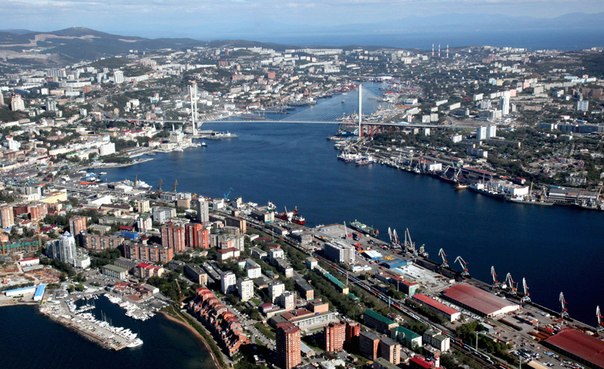
Vladivostok, Primorsky Krai
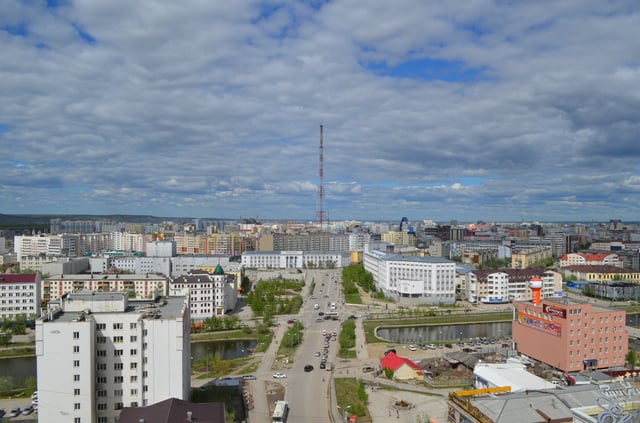
Yakutsk is the capital of the Sakha Republic
The term "Siberia" has a long history. Its meaning has gradually changed during ages. Historically, Siberia was defined as the whole part of Russia to the east of Ural Mountains, including the Russian Far East. According to this definition, Siberia extended eastward from the Ural Mountains to the Pacific coast, and southward from the Arctic Ocean to the border of Russian Central Asia and the national borders of both Mongolia and China.[49]
Soviet-era sources (Great Soviet Encyclopedia and others)[50] and modern Russian ones[51] usually define Siberia as a region extending eastward from the Ural Mountains to the watershed between Pacific and Arctic drainage basins, and southward from the Arctic Ocean to the hills of north-central Kazakhstan and the national borders of both Mongolia and China. By this definition, Siberia includes the federal subjects of the Siberian Federal District, and some of the Ural Federal District, as well as Sakha (Yakutia) Republic, which is a part of the Far Eastern Federal District. Geographically, this definition includes subdivisions of several other subjects of Urals and Far Eastern federal districts, but they are not included administratively. This definition excludes Sverdlovsk Oblast and Chelyabinsk Oblast, both of which are included in some wider definitions of Siberia.
Other sources may use either a somewhat wider definition that states the Pacific coast, not the watershed, is the eastern boundary (thus including the whole Russian Far East)[52] or a somewhat narrower one that limits Siberia to the Siberian Federal District (thus excluding all subjects of other districts).[53] In Russian, the word for Siberia is used as a substitute for the name of the federal district by those who live in the district itself and less commonly used to denote the federal district by people residing outside of it.
| Subject | Administrative center |
|---|---|
| Ural Federal District | |
| Khanty–Mansi Autonomous Okrug | Khanty-Mansiysk |
| Kurgan Oblast | Kurgan |
| Tyumen Oblast | Tyumen |
| Yamalo-Nenets Autonomous Okrug | Salekhard |
| Siberian Federal District | |
| Altai Krai | Barnaul |
| Altai Republic | Gorno-Altaysk |
| Irkutsk Oblast | Irkutsk |
| Republic of Khakassia | Abakan |
| Kemerovo Oblast | Kemerovo |
| Krasnoyarsk Krai | Krasnoyarsk |
| Novosibirsk Oblast | Novosibirsk |
| Omsk Oblast | Omsk |
| Tomsk Oblast | Tomsk |
| Tuva Republic | Kyzyl |
| Far Eastern Federal District | |
| Buryat Republic | Ulan-Ude |
| Sakha (Yakutia) Republic | Yakutsk |
| Zabaykalsky Krai | Chita |
| Subject | Administrative center |
|---|---|
| Far Eastern Federal District | |
| Amur Oblast | Blagoveshchensk |
| Chukotka Autonomous Okrug | Anadyr |
| Jewish Autonomous Oblast | Birobidzhan |
| Kamchatka Krai | Petropavlovsk-Kamchatsky |
| Khabarovsk Krai | Khabarovsk |
| Magadan Oblast | Magadan |
| Primorsky Krai | Vladivostok |
| Sakhalin Oblast | Yuzhno-Sakhalinsk |
| Ural Federal District | |
| Chelyabinsk Oblast | Chelyabinsk |
| Sverdlovsk Oblast | Yekaterinburg |
Major cities
The most populous city of Siberia, as well as the third most populous city of Russia, is the city of Novosibirsk. Other major cities include:
Barnaul
Irkutsk
Kemerovo
Krasnoyarsk
Novokuznetsk
Omsk
Tomsk
Tyumen
Wider definitions of Siberia also include:
Chelyabinsk
Vladivostok
Yekaterinburg – Some sources such as Encyclopædia Britannica include this city as it lies in the Ural Mountains. Inhabitants have distanced themselves though saying that there is a difference between Siberian and Urals culture.[54]
Economy
Siberia is extraordinarily rich in minerals, containing ores of almost all economically valuable metals. It has some of the world's largest deposits of nickel, gold, lead, coal, molybdenum, gypsum, diamonds, diopside, silver and zinc, as well as extensive unexploited resources of oil and natural gas.[55] Around 70% of Russia's developed oil fields are in the Khanty-Mansiysk region.[56] Russia contains about 40% of the world's known resources of nickel at the Norilsk deposit in Siberia. Norilsk Nickel is the world's biggest nickel and palladium producer.[57]
Siberian agriculture is severely restricted by the short growing season of most of the region. However, in the southwest where soils are exceedingly fertile black earths and the climate is a little more moderate, there is extensive cropping of wheat, barley, rye and potatoes, along with the grazing of large numbers of sheep and cattle. Elsewhere food production, owing to the poor fertility of the podzolic soils and the extremely short growing seasons, is restricted to the herding of reindeer in the tundra—which has been practiced by natives for over 10,000 years. Siberia has the world's largest forests. Timber remains an important source of revenue, even though many forests in the east have been logged much more rapidly than they are able to recover. The Sea of Okhotsk is one of the two or three richest fisheries in the world owing to its cold currents and very large tidal ranges, and thus Siberia produces over 10% of the world's annual fish catch, although fishing has declined somewhat since the collapse of the USSR.[58]
While the development of renewable energy in Russia is held back by the lack of a conducive government policy framework,[59] Siberia still offers special opportunities for off-grid renewable energy developments. Remote parts of Siberia are too costly to connect to central electricity and gas grids, and have therefore historically been supplied with costly diesel, sometimes flown in by helicopter. In such cases renewable energy is often cheaper.[60]
Sport

KHL game HC Sibir Novosibirsk vs Amur Khabarovsk

Opening Ceremony of the 2019 Winter Universiade
Professional football teams include FC Tom Tomsk, FC Sibir Novosibirsk and FK Yenisey Krasnoyarsk.
The Yenisey Krasnoyarsk basketball team has played in the VTB United League since 2011–12.
Russia's third most popular sport, bandy,[61] is important in Siberia. In the 2015–16 Russian Bandy Super League season Yenisey from Krasnoyarsk became champions for the third year in a row by beating Baykal-Energiya from Irkutsk in the final.[62][63] Two or three more teams (depending on the definition of Siberia) play in the Super League, the 2016–17 champions SKA-Neftyanik from Khabarovsk as well as Kuzbass from Kemerovo and Sibselmash from Novosibirsk. In 2007 Kemerovo got Russia's first indoor arena specifically built for bandy.[64] Now Khabarovsk has the world's largest indoor arena specifically built for bandy, Arena Yerofey.[65] It was venue for Division A of the 2018 World Championship. In time for the 2020 World Championship, an indoor arena will be ready for use in Irkutsk. That one will also have a speed skating oval.[66]
The 2019 Winter Universiade was hosted by Krasnoyarsk.
Demographics
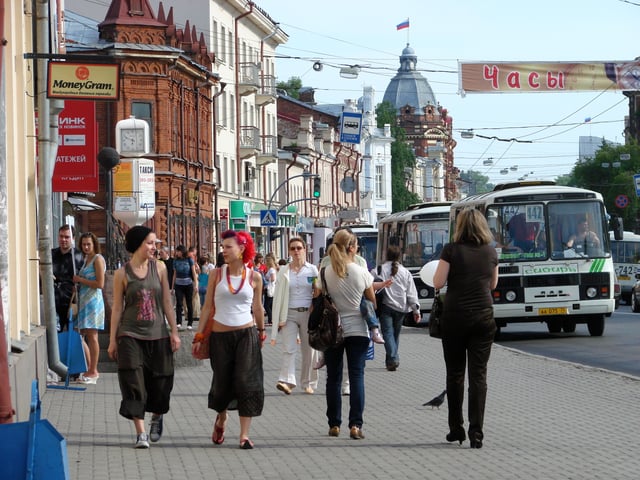
Tomsk, one of the oldest Siberian cities, was founded in 1604.
According to the Russian Census of 2010, the Siberian and Far Eastern Federal Districts, located entirely east of the Ural Mountains, together have a population of about 25.6 million. Tyumen and Kurgan Oblasts, which are geographically in Siberia but administratively part of the Urals Federal District, together have a population of about 4.3 million. Thus, the whole region of Asian Russia (or Siberia in the broadest usage of the term) is home to approximately 30 million people.[67] It has a population density of about three people per square kilometre.
Among the largest non-Slavic group of Russian citizens of Siberia are the approximately 400,000 ethnic Volga Germans,[69] Russified Romanians with ancestral origins from Bessarabia (present-day Moldova) also live in Siberia. The original indigenous groups of Siberia, including Mongol and Turkic groups such as Buryats, Tuvinians, Yakuts, and Siberian Tatars still mostly reside in Siberia, though they are minorities outnumbered by all other non-indigenous Siberians. Indeed, Slavic-origin Russians by themselves outnumber all of the indigenous peoples combined, both in Siberia as a whole and its cities, except in the Republic of Tuva.
Slavic-origin Russians make up the majority in the Buryat, Sakha, and Altai Republics, outnumbering the indigenous Buryats, Sakha, and Altai. The Buryat make up only 25% of their own republic, and the Sakha and Altai each are only one-third, and the Chukchi, Evenk, Khanti, Mansi, and Nenets are outnumbered by non-indigenous peoples by 90% of the population.[70]
According to the 2002 census there are 500,000 Tatars in Siberia, but of these, 300,000 are Volga Tatars who also settled in Siberia during periods of colonization and are thus also non-indigenous Siberians, in contrast to the 200,000 Siberian Tatars which are indigenous to Siberia.[71]
Of the indigenous Siberians, the Buryats, numbering approximately 500,000, are the most numerous group in Siberia, and they are mainly concentrated in their homeland, the Buryat Republic.[72] According to the 2002 census there were 443,852 indigenous Yakuts.[73] Other ethnic groups indigenous to Siberia include Kets, Evenks, Chukchis, Koryaks, Yupiks, and Yukaghirs.
About seventy percent of Siberia's people live in cities, mainly in apartments. Many people also live in rural areas, in simple, spacious, log houses. Novosibirsk is the largest city in Siberia, with a population of about 1.5 million. Tobolsk, Tomsk, Tyumen, Krasnoyarsk, Irkutsk, and Omsk are the older, historical centers.
Religion

Transfiguration Cathedral, Khabarovsk
There are a variety of beliefs throughout Siberia, including Orthodox Christianity, other denominations of Christianity, Tibetan Buddhism and Islam.[74] The Siberian Federal District alone has an estimation of 250,000 Muslims. An estimated 70,000 Jews live in Siberia,[75] some in the Jewish Autonomous Region.[76] The predominant religious group is the Russian Orthodox Church.
Tradition regards Siberia the archetypal home of shamanism, and polytheism is popular.[77] These native sacred practices are considered by the tribes to be very ancient. There are records of Siberian tribal healing practices dating back to the 13th century.[78] The vast territory of Siberia has many different local traditions of gods. These include: Ak Ana, Anapel, Bugady Musun, Kara Khan, Khaltesh-Anki, Kini'je, Ku'urkil, Nga, Nu'tenut, Numi-Torem, Numi-Turum, Pon, Pugu, Todote, Toko'yoto, Tomam, Xaya Iccita, Zonget. Places with sacred areas include Olkhon, an island in Lake Baikal.
Transport
Many cities in northern Siberia, such as Petropavlovsk-Kamchatsky, cannot be reached by road, as there are virtually none connecting from other major cities in Russia or Asia. The best way to tour Siberia is through the Trans-Siberian Railway. The Trans-Siberian Railway operates from Moscow in the west to Vladivostok in the east. Cities that are located far from the railway are best reached by air or by the separate Baikal–Amur Railway (BAM).
Culture
Cuisine
See also
Siberian regionalism



